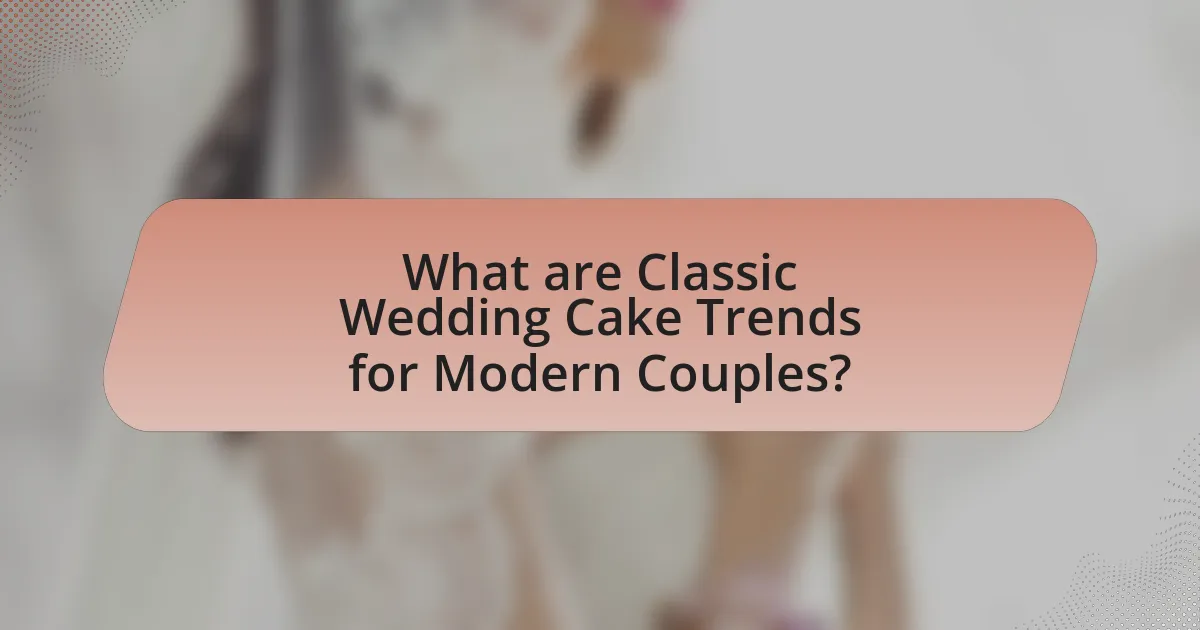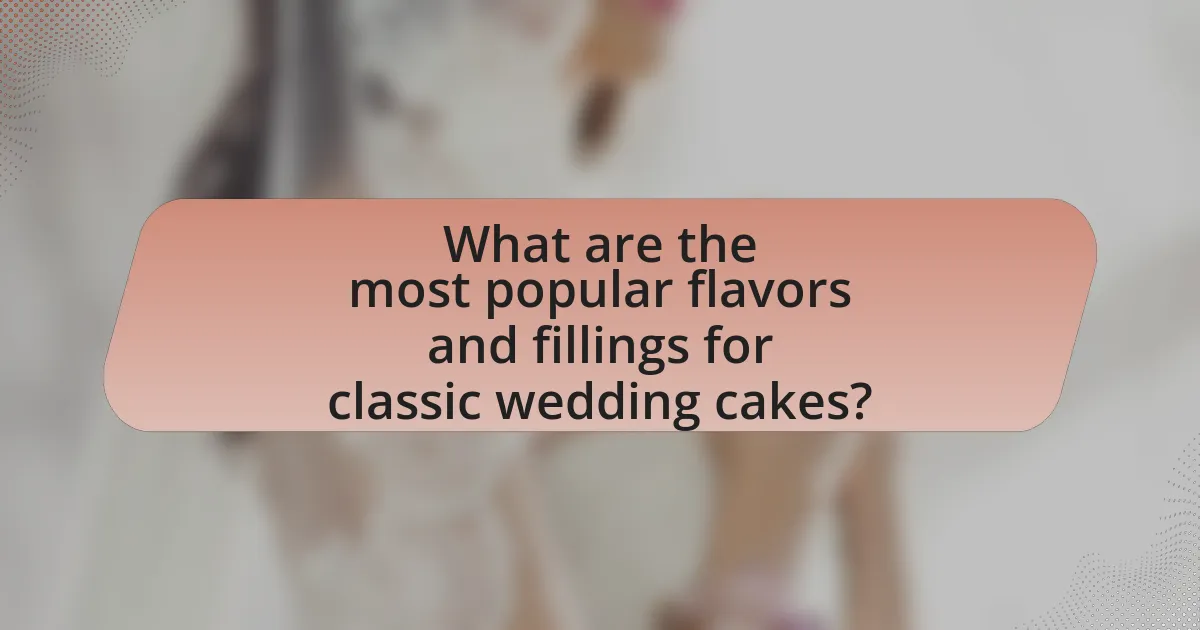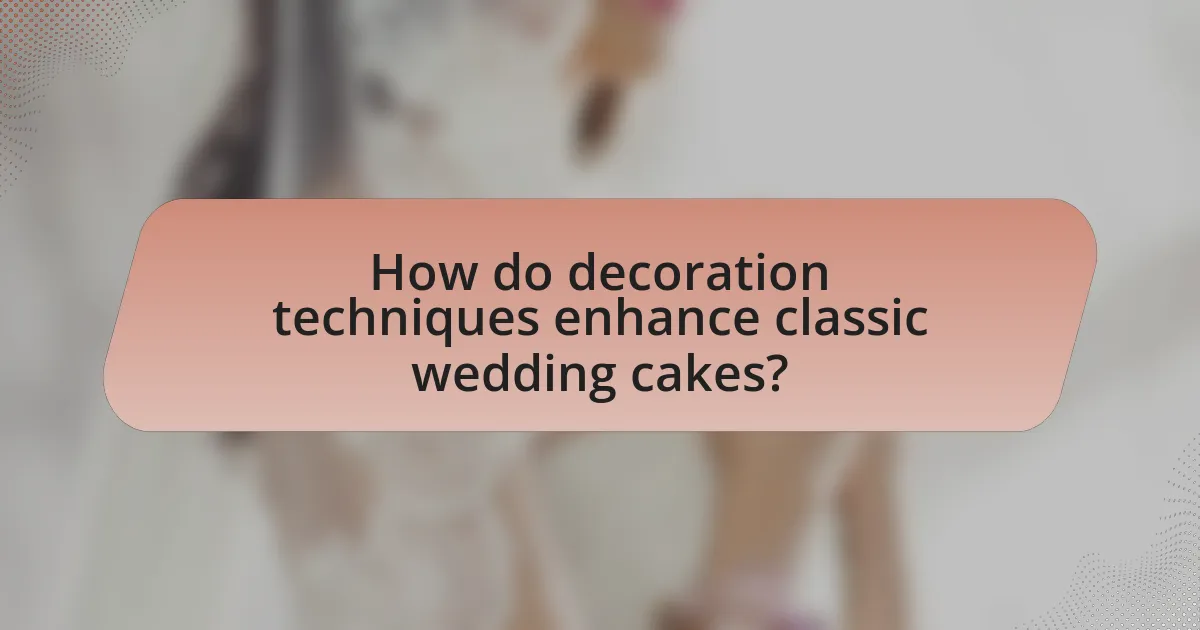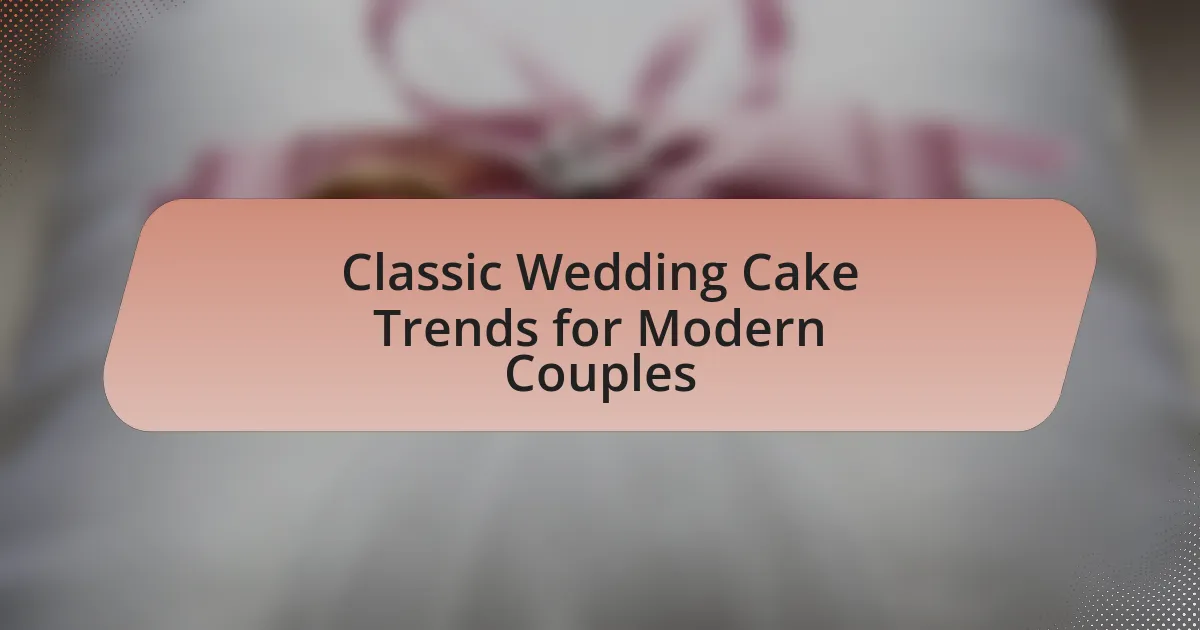Classic wedding cake trends for modern couples emphasize minimalist designs, unique flavor combinations, and the incorporation of natural elements, reflecting a shift towards personalization and sustainability in wedding planning. Traditional wedding cake styles have evolved from simple fruitcakes to elaborate multi-tiered confections, influenced by historical practices and cultural variations. Key characteristics of contemporary classic wedding cakes include diverse flavors, elegant decorations, and the use of fillings that enhance the overall experience. Couples are encouraged to personalize their cakes through unique flavors, decorations, and color schemes, while also considering practical aspects such as budget and guest preferences.

What are Classic Wedding Cake Trends for Modern Couples?
Classic wedding cake trends for modern couples include minimalist designs, unique flavor combinations, and the use of natural elements. Minimalist designs often feature clean lines and simple decorations, reflecting a contemporary aesthetic that prioritizes elegance over extravagance. Unique flavor combinations, such as lavender lemon or chocolate raspberry, cater to diverse palates and enhance the overall wedding experience. Additionally, incorporating natural elements like fresh flowers, fruits, or greenery aligns with the growing trend of sustainability in weddings, making cakes not only visually appealing but also environmentally conscious. These trends are supported by industry reports indicating a shift towards personalization and sustainability in wedding planning.
How have traditional wedding cake styles evolved over time?
Traditional wedding cake styles have evolved from simple fruitcakes to elaborate multi-tiered confections. Historically, wedding cakes were often made of fruitcake, symbolizing fertility and prosperity, and were typically single-tiered. By the Victorian era, the introduction of refined sugar allowed for more intricate designs, leading to the creation of multi-tiered cakes adorned with royal icing and decorative elements. In the 20th century, the rise of fondant and buttercream techniques further transformed wedding cakes, enabling bakers to create smooth finishes and elaborate designs. Today, modern couples often opt for personalized themes, unique flavors, and alternative materials, reflecting individual tastes and contemporary aesthetics, as seen in the increasing popularity of naked cakes and dessert tables.
What historical influences shape modern wedding cake designs?
Modern wedding cake designs are shaped by historical influences such as the medieval tradition of the “bride’s pie,” the Victorian era’s elaborate multi-tiered cakes, and the introduction of sugar paste in the 19th century. The “bride’s pie,” which was a simple cake filled with fruits and spices, evolved into the more decorative and complex cakes seen in the Victorian period, where cakes became symbols of wealth and status, often adorned with intricate designs and multiple tiers. The use of sugar paste, developed in the 1800s, allowed for greater creativity in cake decoration, leading to the fondant-covered cakes popular today. These historical elements collectively inform the aesthetics and symbolism of contemporary wedding cakes, reflecting both tradition and modern tastes.
How do cultural variations impact wedding cake trends?
Cultural variations significantly impact wedding cake trends by influencing flavors, designs, and traditions associated with the cakes. For instance, in many Western cultures, multi-tiered cakes with buttercream or fondant are popular, while in Asian cultures, cakes may incorporate ingredients like red bean or matcha and often feature unique shapes or decorations that reflect cultural symbols. Additionally, specific customs, such as the cutting of the cake or the types of cakes served, vary widely; for example, in some cultures, a fruitcake is traditional, while others may prefer a sponge cake. These differences illustrate how cultural backgrounds shape preferences and practices surrounding wedding cakes, leading to diverse trends that reflect the values and tastes of different communities.
What are the key characteristics of classic wedding cakes today?
Classic wedding cakes today are characterized by multi-tiered designs, elegant decorations, and a variety of flavors. Multi-tiered structures remain popular, often featuring three or more layers that create a visually stunning centerpiece. Elegant decorations include intricate fondant work, delicate piping, and floral arrangements, which enhance the cake’s aesthetic appeal. Additionally, modern couples are opting for diverse flavors beyond traditional vanilla or chocolate, incorporating options like red velvet, lemon, and even unique combinations such as lavender and honey. These characteristics reflect current trends while maintaining the classic essence of wedding cakes.
What flavors are popular in modern classic wedding cakes?
Popular flavors in modern classic wedding cakes include vanilla, chocolate, lemon, red velvet, and almond. These flavors are favored for their broad appeal and versatility, allowing for various fillings and frostings that enhance the overall taste. Vanilla remains a timeless choice, often paired with buttercream or cream cheese frosting, while chocolate offers a rich alternative that can be complemented with ganache or fruit fillings. Lemon provides a refreshing option, especially in warmer months, and red velvet is celebrated for its unique color and flavor profile. Almond flavoring adds a subtle nuttiness that many couples appreciate. These flavors reflect current trends in wedding cakes, emphasizing both tradition and modern preferences.
How do decoration styles reflect contemporary tastes?
Decoration styles reflect contemporary tastes by showcasing current societal values, aesthetics, and preferences in design. For instance, the rise of minimalism in decoration aligns with a contemporary preference for simplicity and functionality, often seen in wedding cake designs that favor clean lines and understated elegance. Additionally, the incorporation of sustainable materials and practices in decoration reflects a growing awareness of environmental issues among modern couples, influencing their choices in cake decoration. This trend is supported by data indicating that 70% of millennials prioritize sustainability in their purchasing decisions, including wedding-related items. Thus, decoration styles serve as a mirror to the evolving tastes and values of society, particularly in the context of modern weddings.
Why are classic wedding cakes still relevant for modern couples?
Classic wedding cakes remain relevant for modern couples due to their timeless appeal and symbolic significance. These cakes often represent tradition, continuity, and the celebration of love, which resonates with couples seeking to honor their heritage while embracing their unique identities. Historical data shows that over 70% of couples still choose traditional tiered cakes for their weddings, indicating a strong preference for classic designs. This enduring popularity is further supported by the fact that classic wedding cakes can be customized with modern flavors and decorations, allowing couples to blend tradition with contemporary tastes.
What emotional significance do classic wedding cakes hold?
Classic wedding cakes hold significant emotional value as symbols of love, commitment, and celebration in marriage. These cakes often represent the couple’s shared journey and the beginning of their life together, serving as a focal point during the wedding reception. Historically, the tradition of wedding cakes dates back to ancient Rome, where cakes were made of wheat or barley and broken over the bride’s head to symbolize fertility and good fortune. This historical context reinforces the cake’s role as a meaningful element in wedding ceremonies, embodying hopes and blessings for the couple’s future.
How do classic designs appeal to modern aesthetics?
Classic designs appeal to modern aesthetics by blending timeless elegance with contemporary simplicity. This fusion is evident in wedding cakes that incorporate traditional elements, such as intricate lace patterns or tiered structures, while utilizing modern color palettes and minimalistic decorations. For instance, a classic white fondant cake adorned with subtle gold accents or fresh flowers can resonate with current trends, appealing to couples who appreciate both heritage and modernity. The enduring popularity of classic designs in wedding cakes is supported by data from wedding industry reports, which indicate that 60% of couples opt for traditional styles with a modern twist, reflecting a desire for nostalgia combined with current tastes.
How can couples choose the right classic wedding cake for their celebration?
Couples can choose the right classic wedding cake by considering their personal tastes, wedding theme, and guest preferences. First, they should select flavors that resonate with both partners, as this will enhance their enjoyment of the cake. Next, the design should align with the overall wedding theme, whether it’s traditional, rustic, or modern, ensuring visual harmony. Additionally, couples should consider the number of guests to determine the cake size, as a well-portioned cake prevents waste and ensures everyone is served. Finally, consulting with a reputable baker who specializes in classic wedding cakes can provide insights into popular trends and help refine their choices, ensuring the cake is both delicious and aesthetically pleasing.
What are the common mistakes to avoid when selecting a wedding cake?
Common mistakes to avoid when selecting a wedding cake include not considering guest preferences, overlooking the cake’s size, and failing to account for dietary restrictions. Couples often choose flavors they like without consulting guests, which can lead to dissatisfaction. Additionally, underestimating the number of servings needed can result in running out of cake, while ignoring dietary needs, such as allergies or vegan options, can alienate some guests. These mistakes can significantly impact the overall experience of the wedding celebration.

What are the most popular flavors and fillings for classic wedding cakes?
The most popular flavors for classic wedding cakes include vanilla, chocolate, and lemon, while common fillings consist of buttercream, cream cheese, and fruit preserves. Vanilla remains a timeless choice due to its versatility and broad appeal, making it a staple in wedding cake flavor profiles. Chocolate is favored for its rich taste, often paired with fillings like ganache or mousse to enhance the experience. Lemon offers a refreshing alternative, particularly in warmer months, and is frequently complemented by fruit-based fillings. These preferences are supported by industry surveys and wedding planning resources, which consistently highlight these flavors and fillings as top choices among couples.
How do flavor trends influence cake choices for weddings?
Flavor trends significantly influence cake choices for weddings by shaping the preferences of couples seeking to personalize their celebrations. As contemporary tastes evolve, couples increasingly opt for unique flavors that reflect their personalities and cultural backgrounds, moving away from traditional vanilla or chocolate options. For instance, recent surveys indicate that flavors like lemon, red velvet, and even exotic options such as matcha or lavender have gained popularity, aligning with a broader trend towards artisanal and gourmet experiences in wedding catering. This shift is supported by data from wedding industry reports, which show that 40% of couples now prioritize flavor variety over classic choices, demonstrating a clear impact of flavor trends on wedding cake selections.
What are the top flavor combinations for classic wedding cakes?
The top flavor combinations for classic wedding cakes include vanilla and almond, chocolate and raspberry, lemon and blueberry, and red velvet with cream cheese frosting. These combinations are popular due to their balance of sweetness and complementary flavors, appealing to a wide range of tastes. For instance, vanilla and almond provide a rich, aromatic base, while chocolate and raspberry offer a decadent contrast that is often favored in celebratory settings. Lemon and blueberry add a refreshing zest, making them ideal for spring and summer weddings, while red velvet’s unique color and flavor profile make it a timeless choice.
How can couples personalize flavors to reflect their tastes?
Couples can personalize flavors to reflect their tastes by selecting unique combinations of cake flavors, fillings, and frostings that resonate with their individual preferences and shared experiences. For instance, they might choose a chocolate cake with raspberry filling if it represents a favorite dessert they enjoyed together, or opt for a vanilla cake infused with spices that remind them of a memorable trip. Additionally, incorporating elements like seasonal fruits or local ingredients can further enhance the personalization, making the cake a true reflection of their journey as a couple. This approach not only creates a distinctive flavor profile but also adds sentimental value to the wedding cake, aligning with the trend of modern couples seeking to make their celebrations more personal and meaningful.
What role do fillings play in enhancing the wedding cake experience?
Fillings significantly enhance the wedding cake experience by adding flavor, texture, and visual appeal. The variety of fillings, such as fruit preserves, chocolate ganache, or cream cheese, allows couples to personalize their cakes, catering to diverse tastes and preferences. This customization not only makes the cake more enjoyable for guests but also reflects the couple’s unique style and story. Additionally, fillings can create a contrast with the cake layers, enhancing the overall sensory experience, as evidenced by the popularity of multi-layered cakes that feature distinct fillings in each layer, making the cake more memorable.
What are the most popular fillings for classic wedding cakes?
The most popular fillings for classic wedding cakes include vanilla buttercream, chocolate ganache, and fruit preserves. Vanilla buttercream is favored for its rich flavor and versatility, while chocolate ganache adds a decadent touch. Fruit preserves, such as raspberry or lemon curd, provide a refreshing contrast to the sweetness of the cake. These fillings are commonly chosen due to their ability to complement various cake flavors and their widespread appeal among couples and guests.
How can fillings complement the overall cake flavor?
Fillings can enhance the overall cake flavor by adding contrasting or complementary tastes and textures that elevate the cake’s profile. For instance, a rich chocolate cake paired with a tart raspberry filling creates a balance that enhances the sweetness of the cake while providing a refreshing contrast. Additionally, fillings like cream cheese or lemon curd can introduce acidity, which cuts through the richness of butter-based cakes, making each bite more enjoyable. This principle is supported by culinary practices where flavor pairing is essential; for example, the combination of sweet and sour flavors is a well-established technique in dessert making that enhances the overall tasting experience.

How do decoration techniques enhance classic wedding cakes?
Decoration techniques enhance classic wedding cakes by adding visual appeal, personalization, and thematic coherence. Techniques such as fondant smoothing, intricate piping, and the use of edible flowers elevate the aesthetic quality of the cake, making it a focal point at the wedding. For instance, the use of gold leaf or metallic accents can create a luxurious appearance, while hand-painted designs can reflect the couple’s unique story or interests. These enhancements not only make the cake more attractive but also align it with contemporary wedding trends, ensuring it complements the overall wedding theme.
What are the trending decoration styles for classic wedding cakes?
Trending decoration styles for classic wedding cakes include minimalist designs, floral embellishments, and textured finishes. Minimalist designs focus on simplicity, often featuring clean lines and subtle color palettes, which appeal to modern aesthetics. Floral embellishments, particularly with fresh or edible flowers, add a romantic touch and are popular for their natural beauty. Textured finishes, such as ruffles or brush strokes, create visual interest and depth, enhancing the overall elegance of the cake. These styles reflect current preferences for sophistication and personalization in wedding celebrations.
How do fondant and buttercream differ in wedding cake decoration?
Fondant and buttercream differ significantly in wedding cake decoration primarily in texture and appearance. Fondant provides a smooth, polished finish that allows for intricate designs and shapes, making it ideal for elaborate decorations. In contrast, buttercream offers a softer, more textured look, which is easier to work with for simple designs and can be piped into various shapes. Additionally, fondant is less forgiving in terms of temperature and humidity, while buttercream can be more versatile and easier to manipulate for different styles. These differences influence the choice of decorators based on the desired aesthetic and complexity of the wedding cake design.
What are the benefits of using fresh flowers in cake design?
Using fresh flowers in cake design enhances visual appeal and adds a natural aesthetic. Fresh flowers provide vibrant colors and unique textures that elevate the overall presentation of the cake, making it more attractive for events like weddings. Additionally, they can be tailored to match the wedding theme or color palette, creating a cohesive look. The use of fresh flowers also conveys a sense of elegance and sophistication, which is often desired in wedding cake designs. Furthermore, fresh flowers can be sourced locally, supporting local florists and reducing environmental impact.
How can couples incorporate personal touches into their cake decorations?
Couples can incorporate personal touches into their cake decorations by using elements that reflect their unique relationship and shared interests. For instance, they can choose flavors that hold special meaning, such as a favorite dessert from their first date, or incorporate colors that represent their wedding theme or personal style. Additionally, couples can add custom cake toppers that feature their names, initials, or even a figurine that represents a shared hobby, such as traveling or a favorite pet. These personalized elements not only enhance the visual appeal of the cake but also create a meaningful connection to the couple’s story, making the cake a memorable centerpiece at their celebration.
What are some creative ideas for unique cake toppers?
Unique cake toppers can include personalized figurines that represent the couple, such as custom-made dolls or caricatures, which add a personal touch to the cake. Another idea is to use fresh flowers or greenery that match the wedding theme, providing a natural and elegant look. Additionally, incorporating meaningful objects, like vintage items or travel souvenirs, can reflect the couple’s journey together. Edible toppers, such as chocolate sculptures or sugar art, offer a creative and delicious option. Finally, using themed elements, like books for literary lovers or musical notes for music enthusiasts, can create a unique and memorable cake design.
How can couples use color schemes to personalize their wedding cake?
Couples can personalize their wedding cake by selecting a color scheme that reflects their wedding theme and personal style. By incorporating colors from the wedding palette, such as the bridesmaids’ dresses or floral arrangements, couples can create a cohesive look that ties the cake into the overall decor. For example, using pastel shades for a spring wedding or rich jewel tones for a fall celebration can enhance the visual appeal of the cake. Additionally, couples can choose specific icing colors, edible flowers, or decorative elements that align with their chosen color scheme, ensuring that the cake is not only a delicious centerpiece but also a personalized representation of their unique celebration.
What practical tips should couples consider when planning their wedding cake?
Couples should consider their budget, guest count, and flavor preferences when planning their wedding cake. Establishing a budget early helps in selecting a cake that meets financial constraints while accommodating the number of guests ensures there is enough cake for everyone. Additionally, choosing flavors that reflect the couple’s taste can enhance the overall experience. According to a survey by The Knot, 70% of couples prioritize flavor over design, indicating that taste is a significant factor in wedding cake planning.
